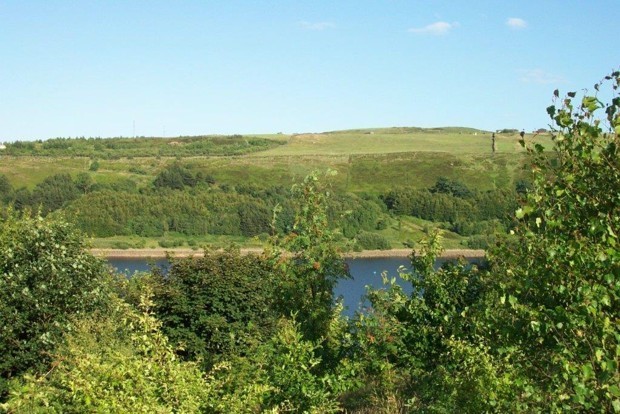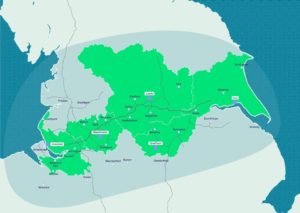On January 7, 2018, ambitious plans were revealed in the UK to create a new “Northern Forest” along the M62 (highway) corridor.
Following backing from the Environment Secretary Michael Gove, over the next 25 years, the Woodland Trust and the Community Forest Trust aim to plant over 50 million trees from one side of Britain to the other; from Liverpool to Hull. The federal government will provide almost £6 million to launch the first project of its kind in over a quarter of a century.
Spanning more than 120 miles between the cities of Bradford, Leeds, Manchester and Liverpool, the proposed Northern Forest will help boost habitats for woodland birds and bats and protect iconic species such as the red squirrel – alongside providing a tranquil space to be enjoyed by millions of people living in the area.
The announcement is part of the government’s upcoming 25 Year Environment Plan, which aims to make this the first British generation to leave the environment in a better state than they inherited it.
In other words, they wish to create a Restoration Economy, as first proposed in The Restoration Economy by Storm Cunningham (Berrett-Koehler, 2002).
In that regard, Prime Minister Theresa May said: “It is vital that we leave our planet in a better state than we found it, with cleaner air, stronger protections for animal welfare and greener spaces for everyone to enjoy. Progress is being made. We’re investing over £3 billion in improving air quality, tackling marine pollution by banning harmful microbeads and increasing sentences for animal cruelty to five years. But to create an environment fit for the future we can’t stop there, and that is why we are supporting the creation of this new Northern Forest and will shortly be setting out our ambitious vision to further support the environment and protect its good health for generations to come.”
The Woodland Trust and Community Forests will use new and innovative mechanisms to engage communities and a wide range of partners in delivering the forest.
With the Government backing growth, investment and jobs across the Northern Powerhouse as part of efforts to create an economy that works for everyone, the Woodland Trust and Community Forest Trust estimate this new forest will generate more than £2 billion for the country’s economy. The area’s breath-taking scenery and landscape is famous across the world, and this scheme will help bolster it for future generations.
Environment Secretary Michael Gove said: “Trees are some of our most cherished natural assets and living evidence of our investment for future generations. Not only are they a source of beauty and wonder, but a way to manage flood risk, protect precious species, and create healthier places for us to work and live. This new Northern Forest is an ambitious and exciting project that will create a vast ribbon of woodland cover in northern England stretching from coast to coast, providing a rich habitat for wildlife to thrive, and a natural environment for millions of people to enjoy.”
The first planting will begin in March this year, supported by funding from the Heritage Lottery Fund, at the Woodland Trust’s 680-hectare Northern Forest flagship site at Smithills, Bolton. The Woodland Trust is already committed to investing over £10 million in this project and several others over the wider forest area.
The Northern Forest will connect the five Community Forests in the north of England – the Mersey Forest, Manchester City of Trees, South Yorkshire Community Forest, the Leeds White Rose Forest and the HEYwoods Project – with green infrastructure and woodland created in and around major urban centres such as Chester, Liverpool, Leeds, and Manchester.
Paul Nolan, director of the Mersey Forest said: “The Northern Forest will complement the planned £75 billion of hard infrastructure investment across the M62 corridor. We have shown that we can lock up over 7m tonnes of carbon as well as potentially reduce flood risk for 190,000 homes. The Northern Forest can also help to deliver improved health and wellbeing, through programmes such as the Natural Health Service. Community Forest Trust has a long track record of developing partnerships and, most importantly, working with local communities to create new woodlands and manage existing woods in and around our towns and cities. We welcome the government support for the idea and we are looking forward to accelerating the work of the Community Forest Trust across the Northern Forest.”
This project will follow on from the successful National Forest, which transformed 200 square miles of industrial site in the heart of England. That forest now attracts over eight million visitors a year and has seen wildlife like otters, water voles and dragonflies flourish.
The Northern Forest will both accelerate the creation of new woodland and support sustainable management of existing woods right across the area. Many more trees, woods and forests will deliver a better environment for all by: improving air quality in our towns and cities; mitigating flood risk in key catchments; supporting the rural economy through tourism, recreation and timber production; connecting people with nature; and helping to deliver improvements to health and wellbeing through welcoming and accessible local green spaces.
With a population in excess of 13m that is expected to rise by 9% over the next 20 years and with woodland cover at just 7.6%, below the UK average of 13%, and far below the EU average of 44%, the North of England is ripe to reap the benefits of such a project.
Tree planting rates are dramatically low with tree planting in 2016 being only 700 hectares against the Government’s target of 5000 hectares a year; there is a need for drastic change.
Austin Brady, director of conservation, Woodland Trust said: “England is losing tree cover. We need to make sure we are protecting our most important habitats such as ancient woodland as well as investing in new major woodland creation schemes. Existing approaches to increasing woodland cover are stalling and existing delivery mechanisms, such as Community Forests are under threat. A new Northern Forest could accelerate the benefits of community forestry, support landscape scale working for nature, deliver a wide range of benefits, including helping to reduce flood risk, and adapt some of the UK’s major towns and cities to projected climate change. The North of England is perfectly suited to reap the benefits of a project on this scale. But this must be a joined-up approach. We’ll need to continue to work with Government, and other organisations to harness new funding mechanisms such as those promised in the Clean Growth Strategy to plant extensive areas of woodland to lock up carbon. This will ensure we can make a difference long term.”
Featured photo by Guy Thompson of the Woodland Trust shows White Rose Forest, which would become part of the Northern Forest.


